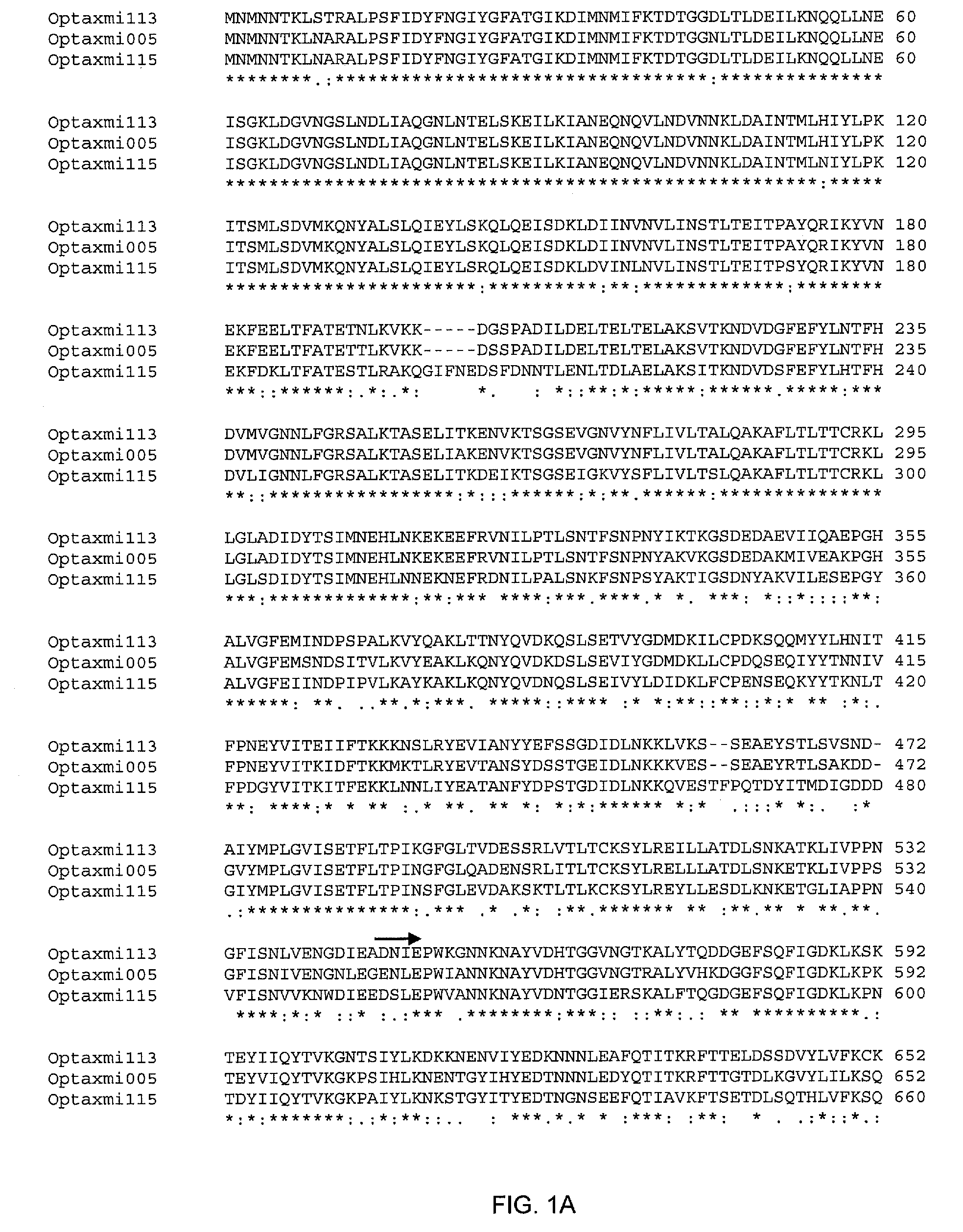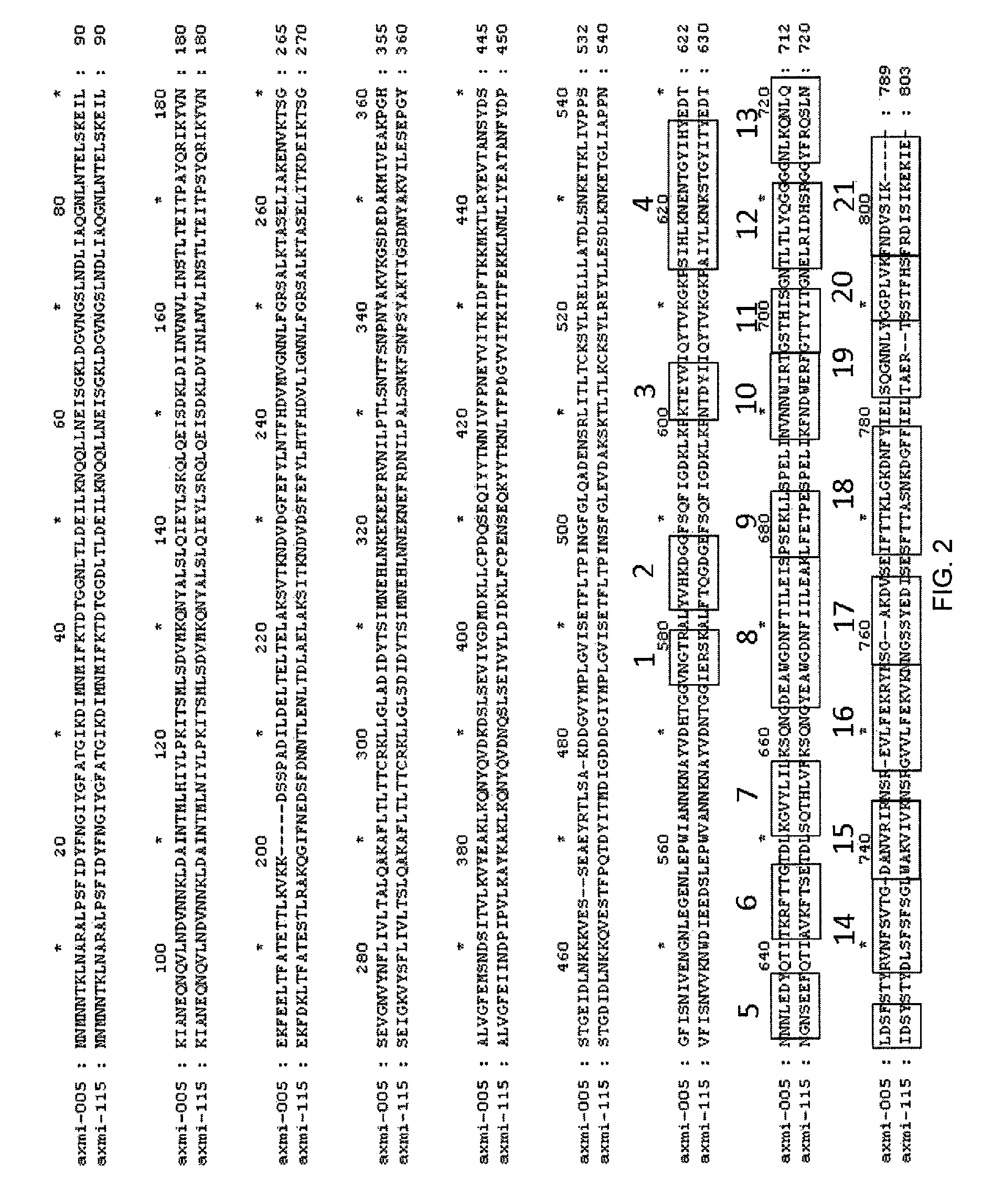AXMI-115, AXMI-113, AXMI-005, AXMI-163 and AXMI-184: insecticidal proteins and methods for their use
a technology of insecticidal proteins and insecticides, applied in the field of molecular biology, can solve problems such as larval death
- Summary
- Abstract
- Description
- Claims
- Application Information
AI Technical Summary
Benefits of technology
Problems solved by technology
Method used
Image
Examples
example 1
Discovery of a Novel Toxin Gene Axmi115 from the Bacillus thuringiensis Strain ATX12983
[0150]The complete gene sequence was identified from the selected strain via the MiDAS genomics approach as follows:[0151]Preparation of extrachromosomal DNA from the strain. Extrachromosomal DNA contains a mixture of some or all of the following: plasmids of various size; phage chromosomes; genomic DNA fragments not separated by the purification protocol; other uncharacterized extrachromosomal molecules.[0152]Mechanical or enzymatic shearing of the extrachromosomal DNA to generate size-distributed fragments.[0153]Sequencing of the fragmented DNA[0154]Identification of putative toxin genes via homology and / or other computational analyses.[0155]When required, sequence finishing of the gene of interest by one of several PCR or cloning strategies (e.g. TAIL-PCR).
The novel gene is referred to herein as axmi-115 (SEQ ID NO:3), and the encoded amino acid referred to as AXMI-115 (SEQ ID NO:6). Synthetic ...
example 2
Novel Insecticidal Protein AXMI-005 from the Bacillus Thuringiensis Strain ATX13002
[0165]The AXMI-005 insecticidal gene was identified from the strain ATX13002 using the MiDAS approach as described in U.S. Patent Publication No. 20040014091, which is herein incorporated by reference in its entirety, using the following steps:
Steps taken in the current strategy to gene discovery:
[0166]Step 1: Culture from the strain was grown in large quantities. The plasmid DNA was then separated from the chromosomal DNA by a cesium chloride gradient spun in an ultracentrifuge. The purified plasmid DNA was then nebulized to a 5-10 kb size range appropriate for coverage of an average sized coding region. The fragment ends were polished then ligated overnight into a vector cut with a restriction enzyme producing blunt ends.[0167]Step 3: Once the shotgun library quality was checked and confirmed, colonies were grown, prepped and sequenced in a 96-well format. The library plates were end sequenced off o...
example 3
Discovery of a Novel Toxin Gene Axmi-113 from the Bacillus thuringiensis Strain ATX12987
[0172]The complete gene sequence was identified from the selected strain via the MiDAS genomics approach as follows:[0173]Preparation of extrachromosomal DNA from the strain. Extrachromosomal DNA contains a mixture of some or all of the following: plasmids of various size; phage chromosomes; genomic DNA fragments not separated by the purification protocol; other uncharacterized extrachromosomal molecules.[0174]Mechanical or enzymatic shearing of the extrachromosomal DNA to generate size-distributed fragments.[0175]Sequencing of the fragmented DNA[0176]Identification of putative toxin genes via homology and / or other computational analyses.[0177]When required, sequence finishing of the gene of interest by one of several PCR or cloning strategies (e.g. TAIL-PCR).
The novel gene is referred to herein as axmi-113 (SEQ ID NO:2), and the encoded amino acid referred to as AXMI-113 (SEQ ID NO:5).[0178]Gene...
PUM
| Property | Measurement | Unit |
|---|---|---|
| temperature | aaaaa | aaaaa |
| temperature | aaaaa | aaaaa |
| pH | aaaaa | aaaaa |
Abstract
Description
Claims
Application Information
 Login to View More
Login to View More - R&D
- Intellectual Property
- Life Sciences
- Materials
- Tech Scout
- Unparalleled Data Quality
- Higher Quality Content
- 60% Fewer Hallucinations
Browse by: Latest US Patents, China's latest patents, Technical Efficacy Thesaurus, Application Domain, Technology Topic, Popular Technical Reports.
© 2025 PatSnap. All rights reserved.Legal|Privacy policy|Modern Slavery Act Transparency Statement|Sitemap|About US| Contact US: help@patsnap.com



